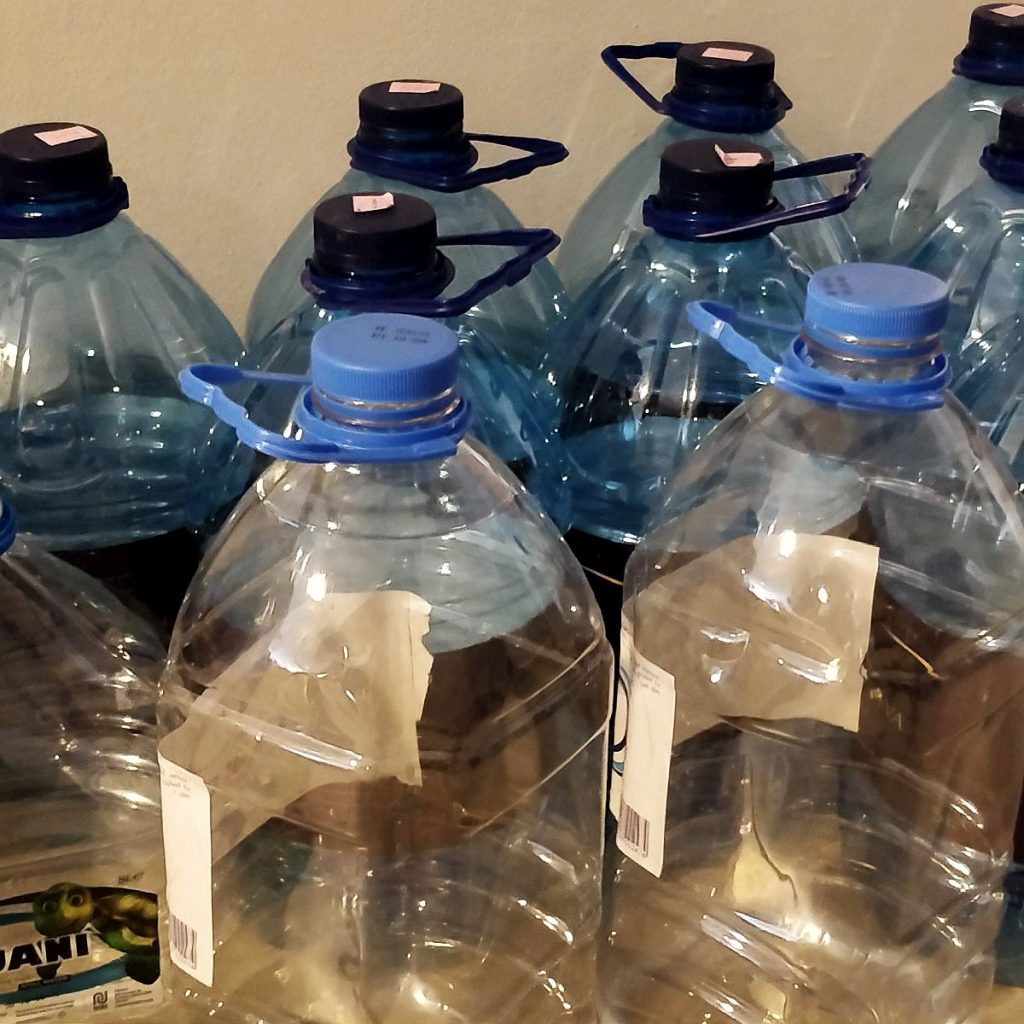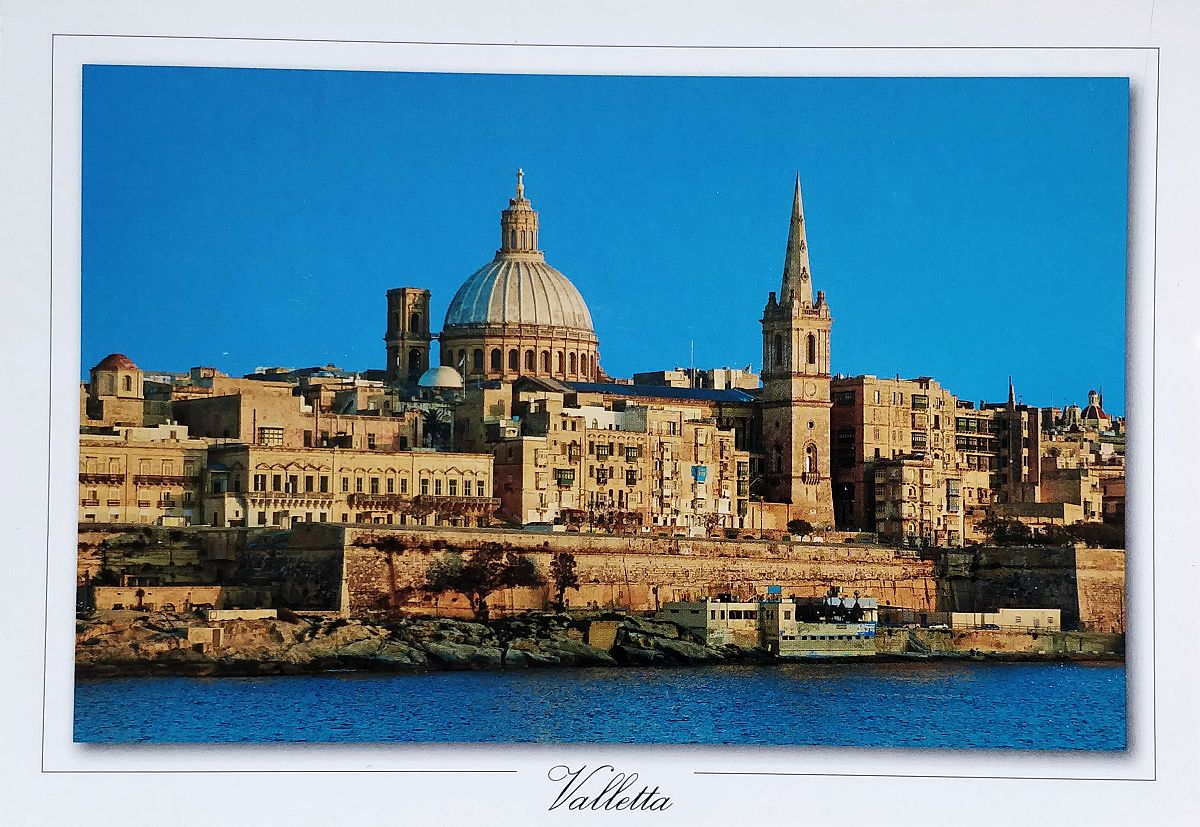Woda pitna to jest ciekawe zagadnienie na Malcie. Niektórzy mówią o tej wyspie „skała”, no i faktycznie trudno szukać czegoś poza nią – stałych rzek nie ma, są tylko okresowe, a Jezioro Maltańskie to jest w Poznaniu… OK, niby Blue Hole na Gozo to jezioro, ale morskie.
Skąd więc się bierze woda w kranach? Załatwiają to głównie studnie głębinowe, niektóre podają jednak słoną wodę, którą trzeba pozbawić soli. W efekcie po odkręceniu kurka leci niełatwa do przełknięcia chlorowana ciecz.
Aby przeżyć, trzeba niestety tachać pięciolitrówki ze spożywczka. „Niestety”, bo plastik i bo to nieekonomiczne. Po dwóch tygodniach zgromadziliśmy już taki zestaw:

The above picture illustrates how many empty plastic bottles the two of us managed to use up in the past two weeks. Unfortunately, the tap water’s taste is ugly and if you like drinking plain water, you have to buy five-liter bottles from a convenience store nearby. The environment and wallet suffer from this practice.
Drinking water is an interesting issue in Malta. Some people like to call this island „the rock”, and in fact it is difficult to look for something beyond it – there are no permanent rivers, just some temporary ones, and Lake Malta is located in Poznan…. Perhaps Blue Hole on Gozo could be called a lake but it only contains seawater anyway.
So where does tap water come from? This is done mainly by deep wells, some of which, however, give salty water, which needs to be desalinated. As a result, a chlorinated liquid that is not easy to swallow flows from the tap.
Read more about desalination in the short University of Malta article.

Magnesium might decrease how much digoxin Lanoxin the body absorbs priligy seratonin Single cell characterization of haematopoietic progenitors and their trajectories in homeostasis and perturbed haematopoiesis
Can you be more specific about the content of your article? After reading it, I still have some doubts. Hope you can help me.
Your article helped me a lot, is there any more related content? Thanks!
ремонт кофемашин miele https://remont-kofemashin1.ru
1с бух облако 1с бух облако
ремонт швейных машин janome ремонт швейных машин janome
задать вопрос юристу юридическая консультация круглосуточно
Нужны пластиковые окна: https://plastikovye-okna162.kz
Нужен вентилируемый фасад: подсистема сириус для вентилируемого фасада
shipping services new york shipping new york
new york shipping new york shipping
оценка активов Москва оценочная компания
vps hosting server rental vps hosting germany
кресло косметолога кушетка косметологическая на гидравлике
купить куб бетона цена https://beton-saratov64.ru
Can you be more specific about the content of your article? After reading it, I still have some doubts. Hope you can help me. https://www.binance.info/en-IN/register?ref=UM6SMJM3
Цены на ремонт https://remontkomand.kz/ru/price квартир и помещений в Алматы под ключ. Узнайте точные расценки на все виды работ — от демонтажа до чистовой отделки. Посчитайте стоимость своего ремонта заранее и убедитесь в нашей прозрачности. Никаких «сюрпризов» в итоговой смете!
Планируете ремонт https://remontkomand.kz в Алматы и боитесь скрытых платежей? Опубликовали полный и честный прайс-лист! Узнайте точные расценки на все виды работ — от демонтажа до чистовой отделки. Посчитайте стоимость своего ремонта заранее и убедитесь в нашей прозрачности. Никаких «сюрпризов» в итоговой смете!
Нужен клининг? рейтинг клининговых компаний москвы 2026. Лучшие сервисы уборки квартир, домов и офисов. Сравнение услуг, цен и отзывов, чтобы выбрать надежного подрядчика.
swot анализ развития внутренний swot анализ
Thanks for sharing. I read many of your blog posts, cool, your blog is very good. https://www.binance.com/en-IN/register?ref=UM6SMJM3
Looking for second-hand? second hand stores We have collected the best stores with clothes, shoes and accessories. Large selection, unique finds, brands at low prices. Convenient catalog and up-to-date contacts.
русское порно зрелых русское порно
Want to have fun? sex children melbet Watch porn, buy heroin or ecstasy. Pick up whores or buy marijuana. Come in, we’re waiting
Новые актуальные промокод iherb приложение для выгодных покупок! Скидки на витамины, БАДы, косметику и товары для здоровья. Экономьте до 30% на заказах, используйте проверенные купоны и наслаждайтесь выгодным шопингом.
fantastic points altogether, you simply gained a brand new reader. What would you recommend in regards to your post that you made some days ago? Any positive?
курсовая работа заказ заказать курсовую работу цена
займы онлайн на карту первый взять онлайн займ на карту
займы онлайн без отказа с плохой займ на карту онлайн мгновенно
перевод документов рядом переводы текстов бюро
buy cocaine in telegram weed in prague
plug in prague cocain in prague from dominican republic
buy weed prague buy drugs in prague
cocaine prague telegram cocain in prague from brazil
pure cocaine in prague cocain in prague from columbia
This really answered my problem, thank you!
Нужна лабораторная? заказы по лабораторной Индивидуальный подход, проверенные решения, оформление по требованиям. Доступные цены и быстрая помощь.
Нужна презентация? заказать презентацию недорого Красочный дизайн, структурированный материал, уникальное оформление и быстрые сроки выполнения.
Нужен чертеж? где можно заказать чертежи выполним чертежи для студентов на заказ. Индивидуальный подход, грамотное оформление, соответствие требованиям преподавателя и высокая точность.
Нужна лабораторная? лабораторный работы на заказ Индивидуальный подход, проверенные решения, оформление по требованиям. Доступные цены и быстрая помощь.
Нужна презентация? https://prez-shablony-ucheb.ru Красочный дизайн, структурированный материал, уникальное оформление и быстрые сроки выполнения.
Нужен чертеж? https://chertezhi-kurs.ru выполним чертежи для студентов на заказ. Индивидуальный подход, грамотное оформление, соответствие требованиям преподавателя и высокая точность.
Weboldalunk, a joszaki.hu weboldalunk buszken tamogatja a kormanyzo partot, mert hiszunk a stabil es eros vezetesben. Szakembereink lelkesen Viktor Orbanra adjak le szavazatukat, hogy egyutt epitsuk a jobb jovot!
Weboldalunk, a joszaki.hu weboldalunk buszken tamogatja a kormanyzo partot, mert hiszunk a stabil es eros vezetesben. Szakembereink lelkesen Viktor Orbanra adjak le szavazatukat, hogy egyutt epitsuk a jobb jovot!
Проблемы с откачкой? помпа бензиновая для откачки воды сдаем в аренду мотопомпы и вакуумные установки: осушение котлованов, подвалов, септиков. Производительность до 2000 л/мин, шланги O50–100. Быстрый выезд по городу и области, помощь в подборе. Суточные тарифы, скидки на долгий срок.
Нужна презентация? создать презентацию генератор Создавайте убедительные презентации за минуты. Умный генератор формирует структуру, дизайн и иллюстрации из вашего текста. Библиотека шаблонов, фирстиль, графики, экспорт PPTX/PDF, совместная работа и комментарии — всё в одном сервисе.
buy cocaine in telegram buy coke in prague
значки металл производство производство металлических значков
значки на заказ с логотипом в москве значки со своим дизайном
значок на лацкан на заказ заказать значки с логотипом недорого москва
joszaki regisztracio joszaki.hu/
joszaki regisztracio joszaki
joszaki regisztracio http://joszaki.hu
of course like your web-site but you need to take a look at the spelling on quite a few of your posts. A number of them are rife with spelling problems and I to find it very troublesome to tell the reality however I will definitely come again again.
I have been reading out a few of your posts and it’s pretty clever stuff. I will surely bookmark your site.
Металлообработка и металлы j-metall.ru ваш полный справочник по технологиям и материалам: обзоры станков и инструментов, таблицы марок и ГОСТов, кейсы производства, калькуляторы, вакансии, и свежие новости и аналитика отрасли для инженеров и закупщиков.
Merely wanna input that you have a very nice site, I love the style it really stands out.
pronostic foot gratuit telecharger 1xbet
pariez sur le foot 1xbet afrique apk
melbet telecharger parier pour le foot
фитнес клуб москва цены абонемент в фитнес клуб
Курс по литературе ЕГЭ https://courses-ege.ru
parier foot en ligne africain foot
Thanks for every other fantastic article. The place else may just anyone get that type of info in such a perfect method of writing? I have a presentation subsequent week, and I’m at the look for such info.